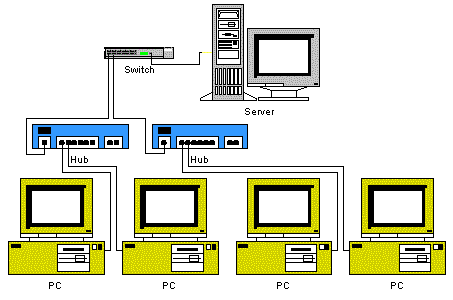![]()

Switched ethernet is a packet-switching technology that dramatically reduces the network congestion caused by using the CSMA/CD medium access control over shared media. Sometimes known as a switched hub, a switch offers guaranteed bandwidth per port and operates at the medium access control sublayer of the network access layer of the TCP/IP protocol suite.
The introduction of switching can overcome congestion, due to the non-deterministic nature of CSMA/CD, by dynamically routing frames across networks. Don't confuse switches with routers - strictly speaking, switches are layer two devices and routers operate at layer three. Just to confuse matters, layer three switches are being developed to support the growing needs of large corporate intranets. The first generation of layer 3 switches were known as High Function switches. These devices employed a mixture of hardware switching and software routing. This represented a compromise because the performance benefits of switching were sometimes lost with the reliance on slow software. The new generation of layer three switches route using hardware only.

A switch will examine the incoming frame's MAC header to determine the physical address of the destination device. Whereas a hub simply repeats an incoming frame out of all its ports, the switch creates a virtual path to forward frames to the port where it knows the destination device exists.
CSMA/CD is no longer required, each device on a switched network has guaranteed access to the media through the switch. Switches can also provide some flow control to network traffic by temporarily storing frames in a buffer. Flow control is necessary when switches are used between clients operating over 10BaseT and servers using 100BaseT.
Switches can also generate backpressure to cause transmitting devices to wait long enough for the switch to deal with backlogged traffic. To create backpressure, the switch broadcasts false collision detection signals to cause network interface cards to back off. It is ironic that switches must sometimes mimic the CSMA/CD access methodology that they negate.
In order to operate effectively, switches maintain their own MAC look-up tables. These table illustrate which network device is at which port on the switch. The look-up tables are constantly updated. When a switch is newly installed, it will construct its table via an Address Resolution Protocol (ARP) broadcast. ARP is a TCP/IP layer 3 protocol.
The animated gif image shows the essential difference between a switch and a hub. Note how the switch routes the frame to the right hand segment, whereas the hub merely repeats the frame out of both ports.
There are three sorts of layer 2 switches:
| Lantronix switch tutorial | Good switching tutorial |
| Switches - Central Institute of Technology | General switched ethernet information |
| Xylan switching information | Another good commercial resource |